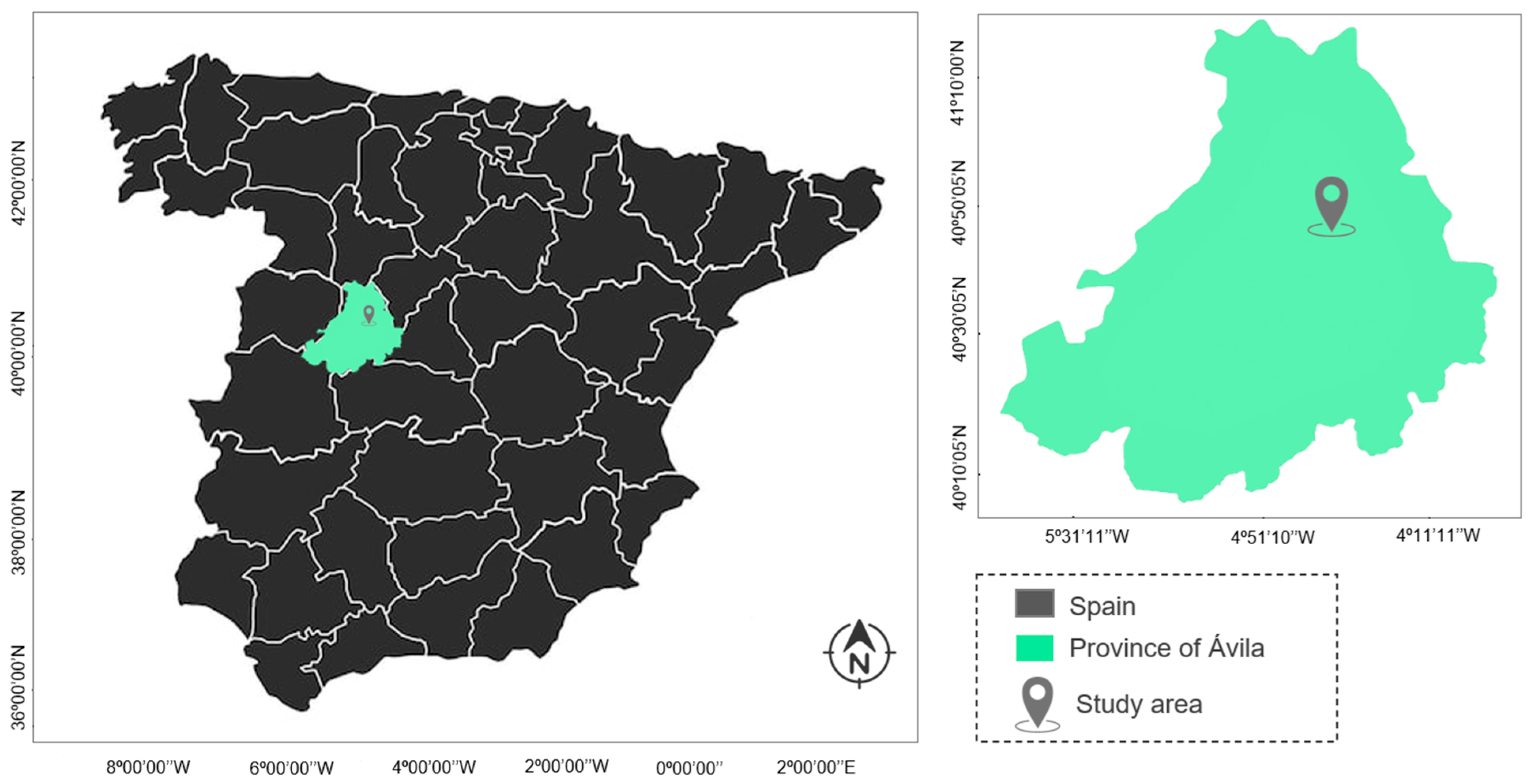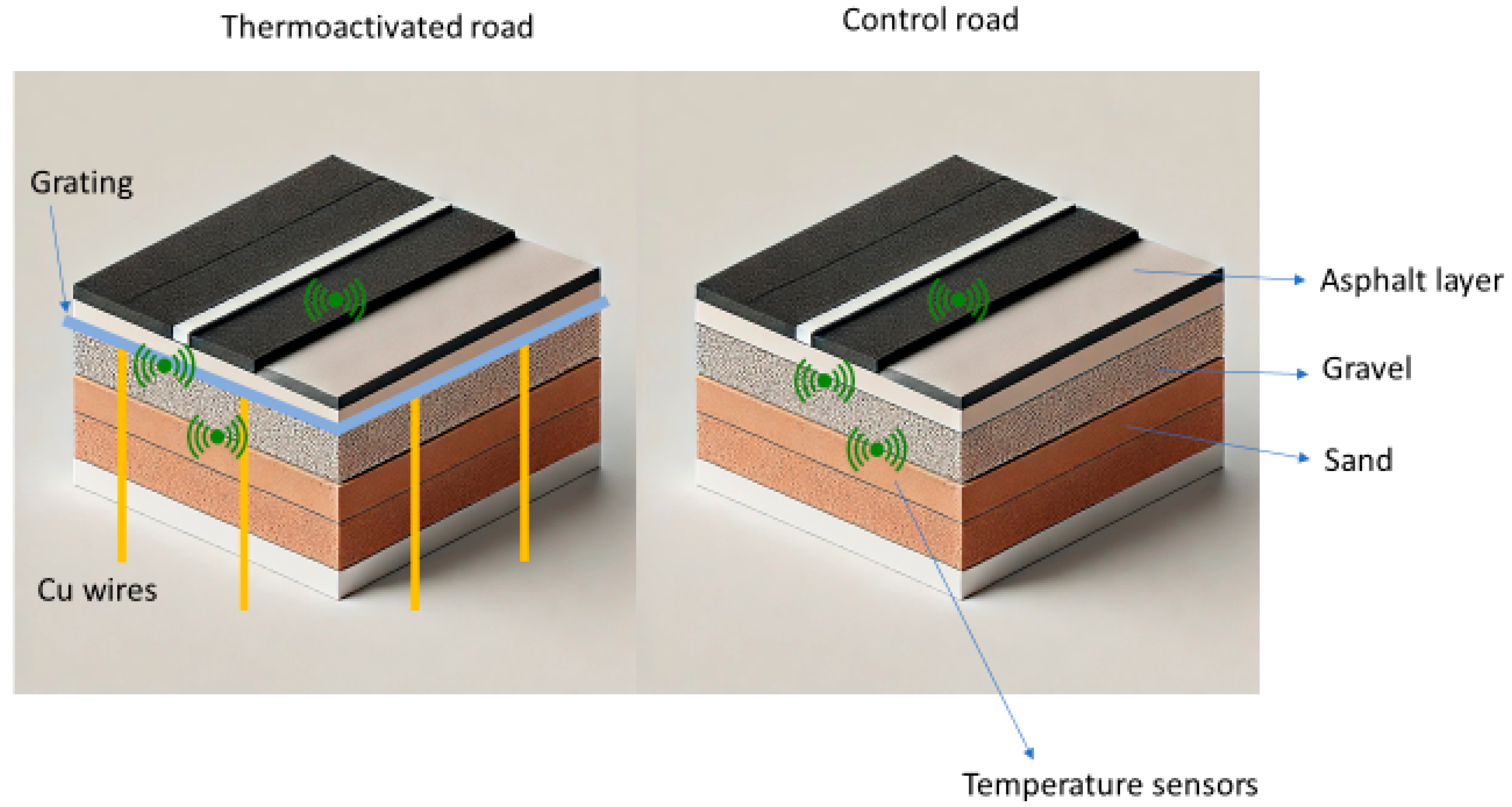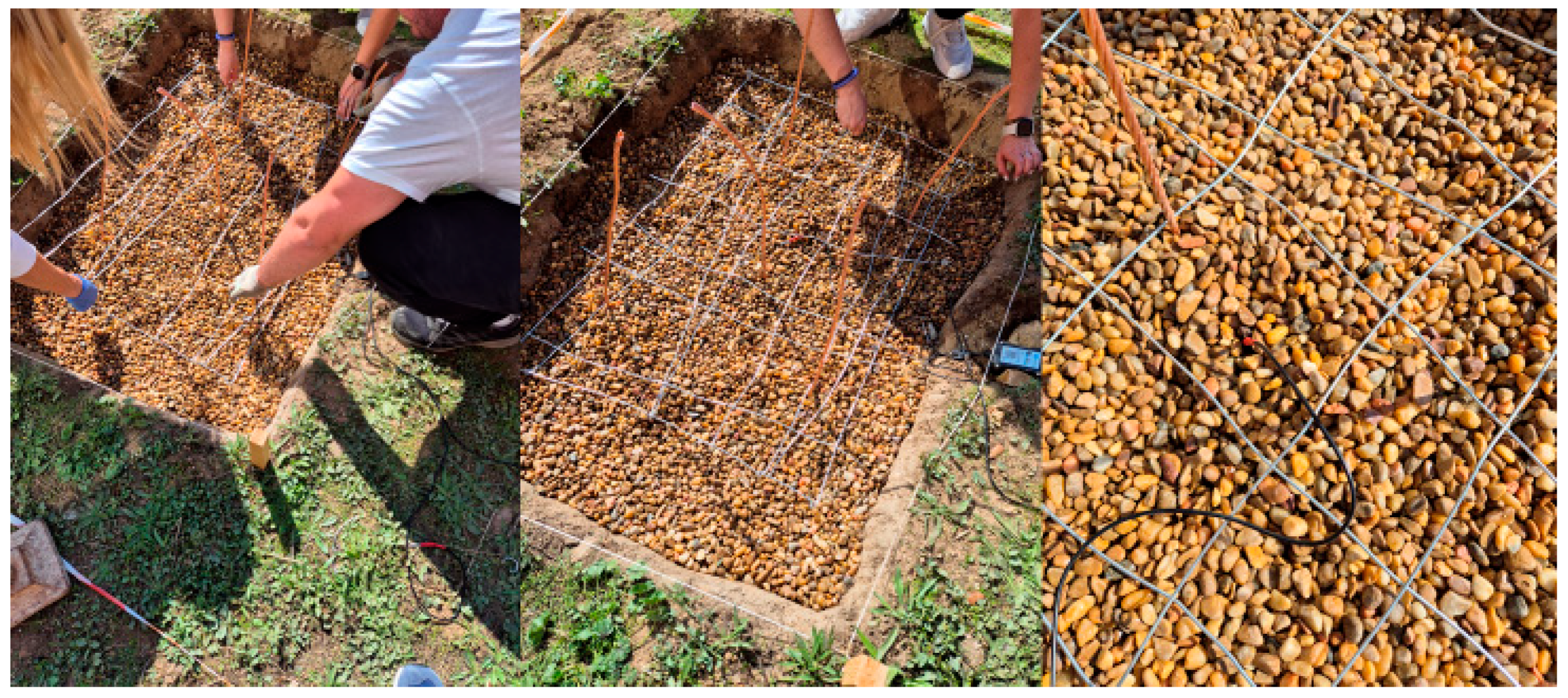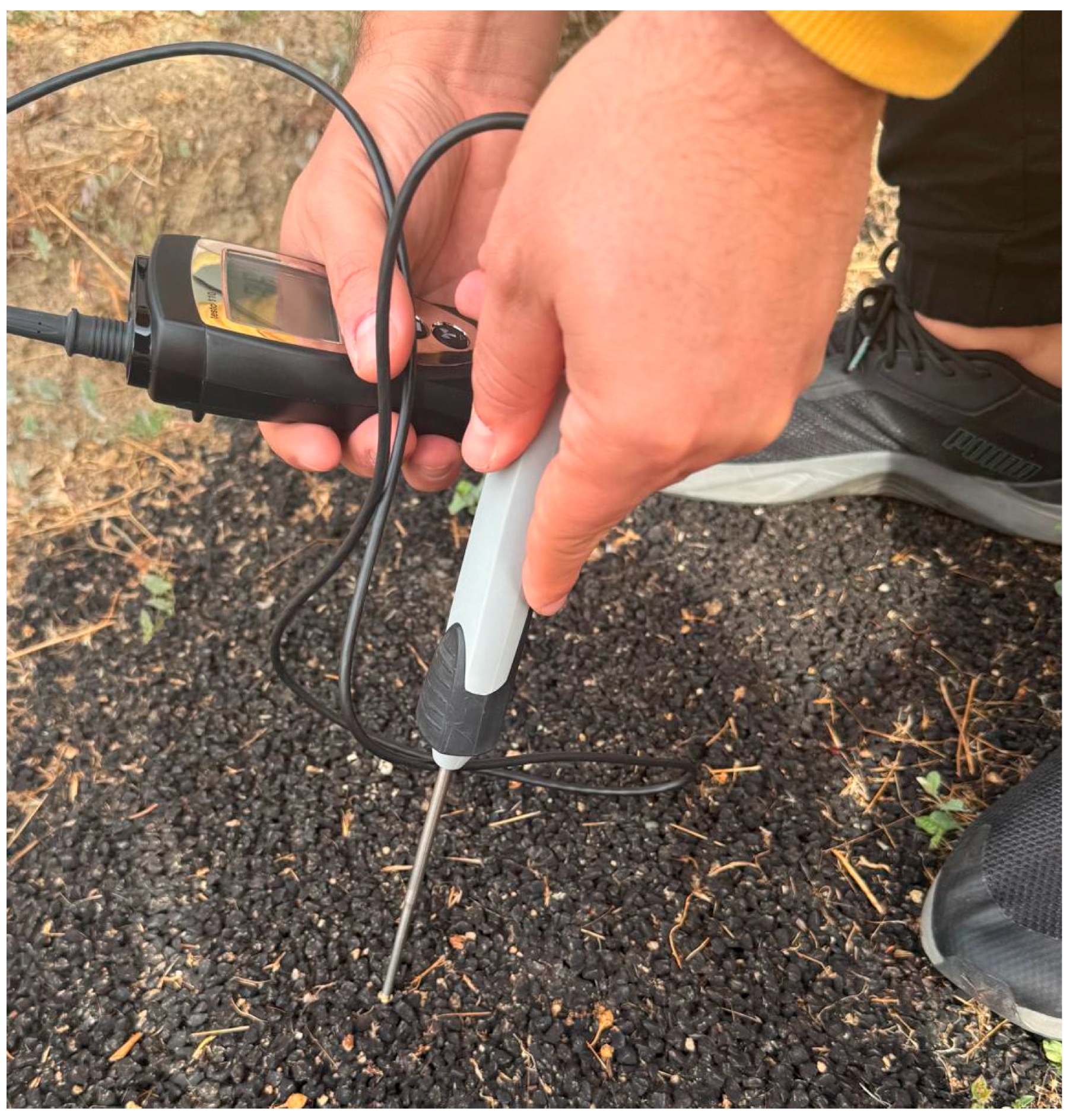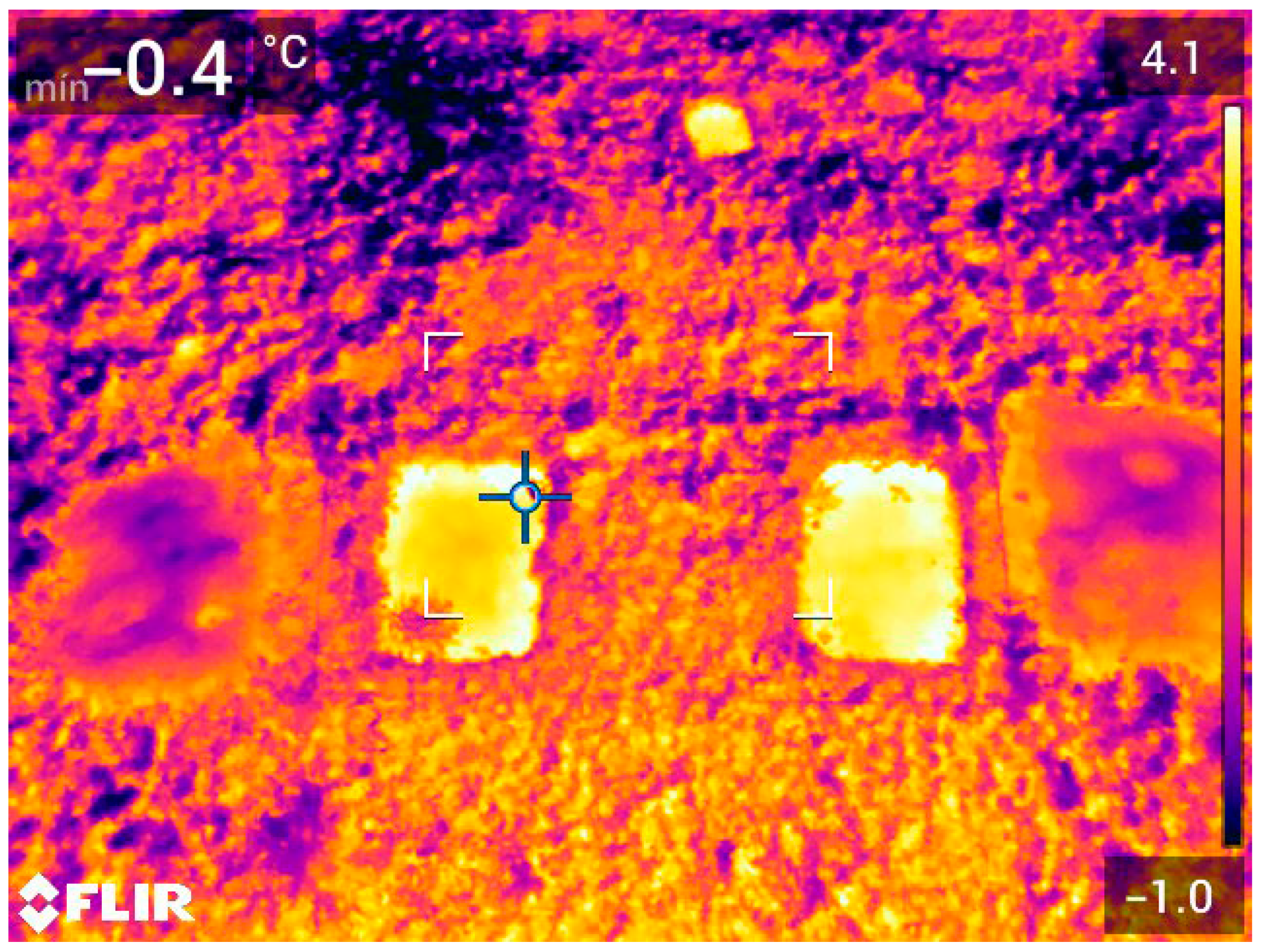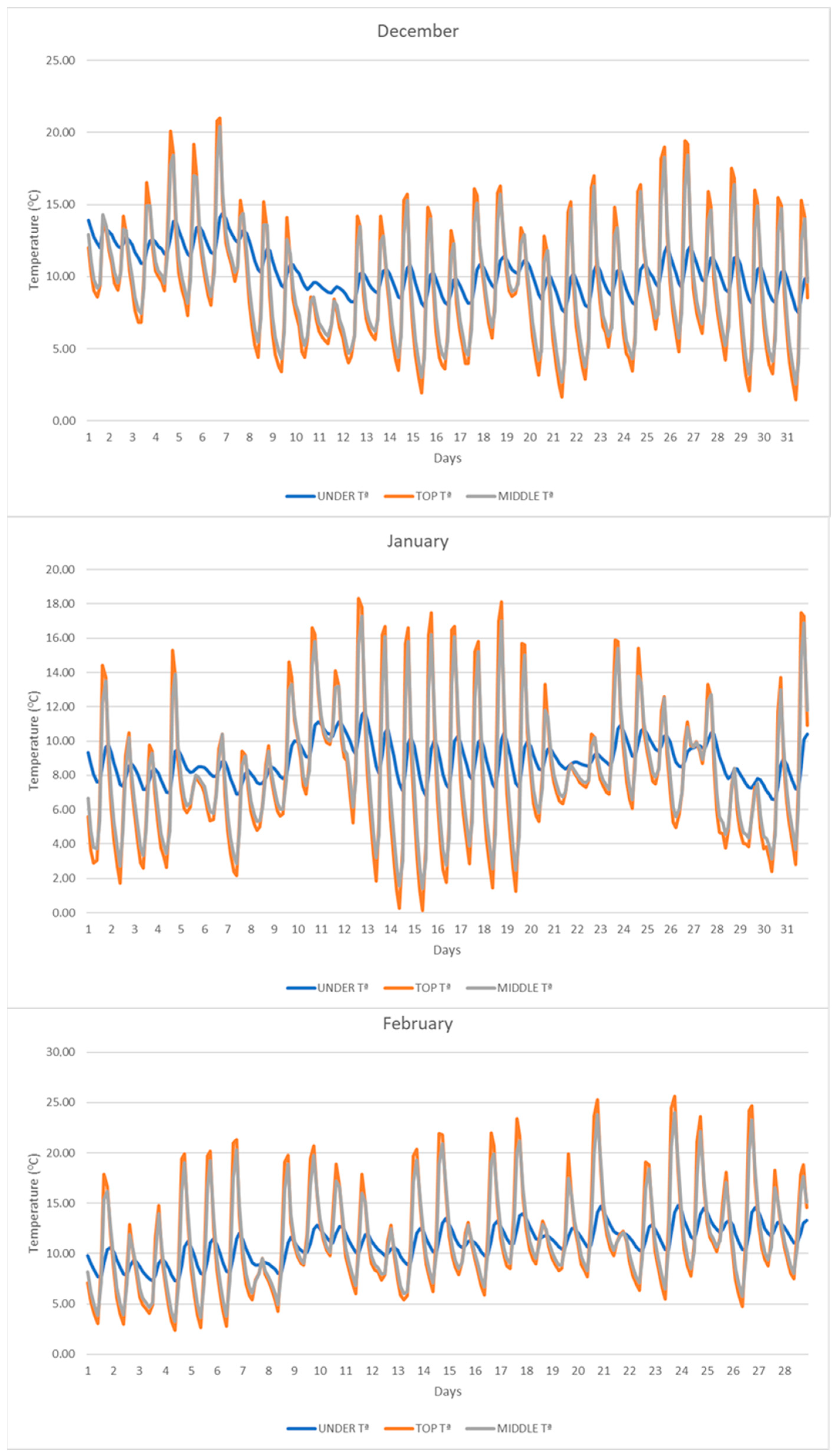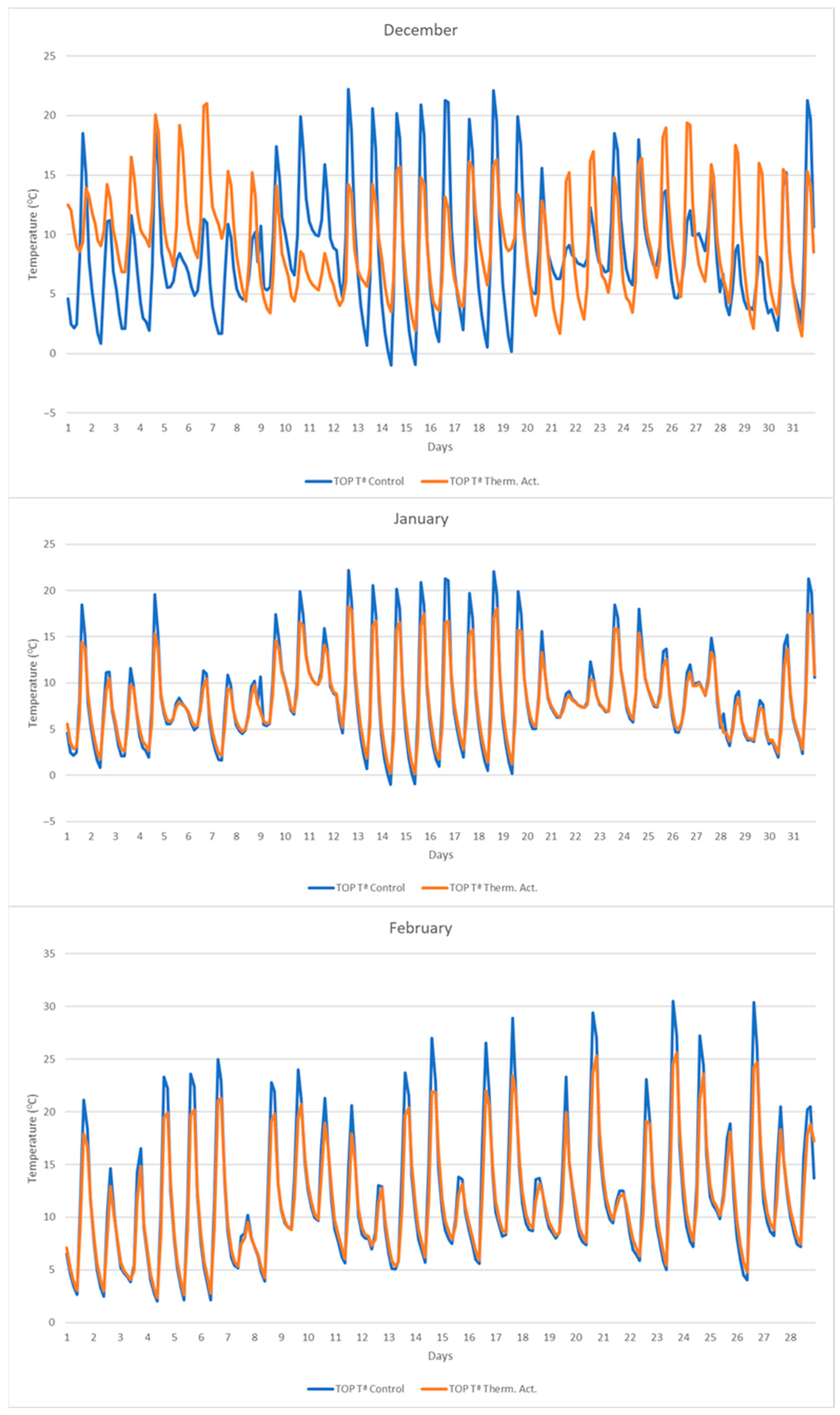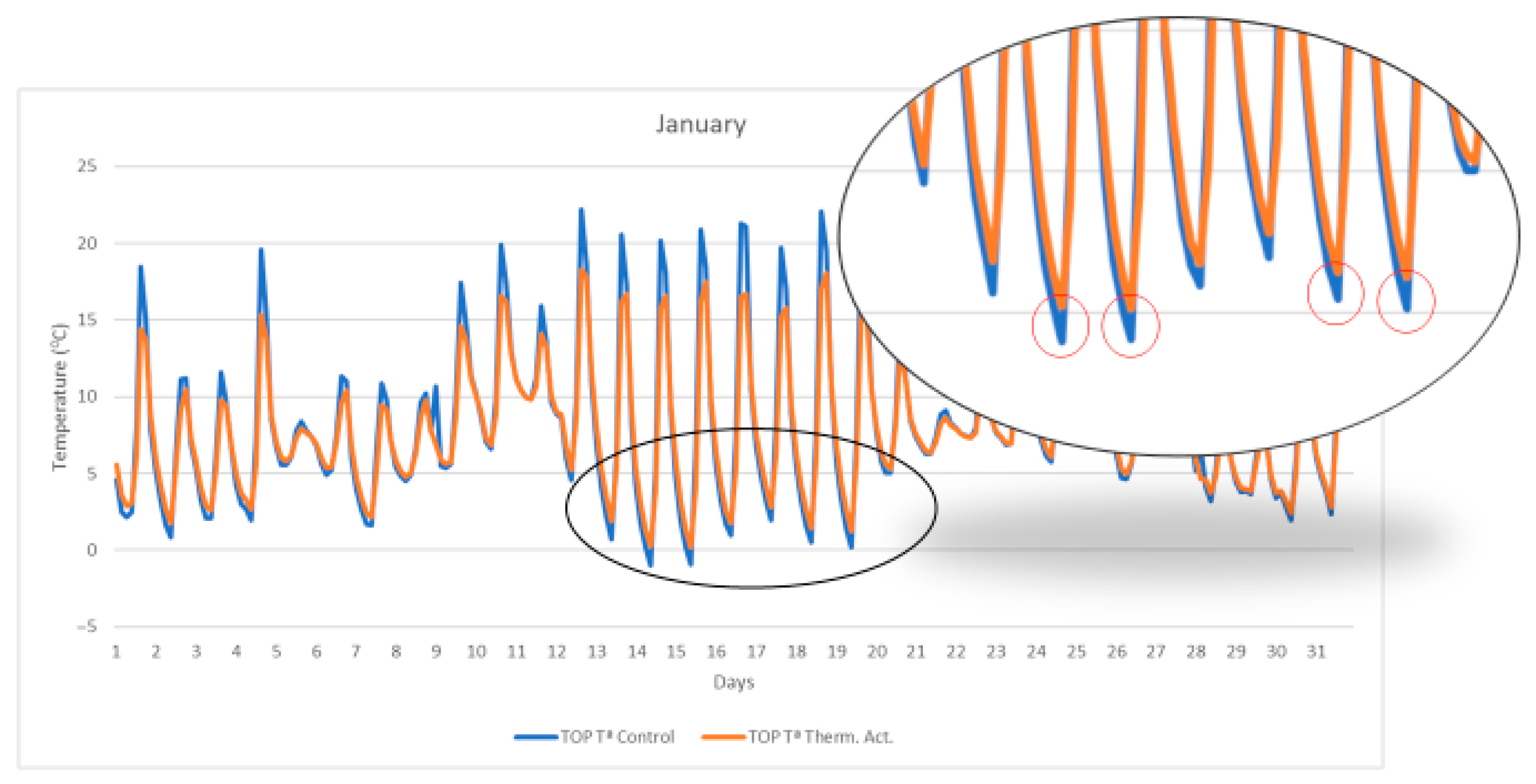1. Introduction
Transportation networks constitute critical infrastructure for economic development, territorial integration, and societal welfare, as they provide the necessary framework for the efficient and reliable movement of goods, services, and people [
1]. Roads, which represent the most widely used component of land transportation systems, play a particularly crucial role in guaranteeing accessibility to remote areas, supporting local and regional economies, and facilitating emergency response operations [
2,
3]. In this sense, ensuring that road networks remain functional under adverse weather conditions is essential for maintaining economic activity, public safety, and quality of life. However, keeping roads safe throughout the year is a challenging and resource-intensive task. It requires constant maintenance, significant financial investment, and timely interventions and yet does not always guarantee effective mitigation of hazards, particularly when facing extreme weather events [
4,
5].
From an analytical perspective, this highlights a key research gap: while the im-portance of road maintenance is well recognized, there is limited understanding of how current strategies perform under increasing climatic variability and extreme weather events. Existing literature often describes the problem but rarely quantifies the trade-offs between cost, safety, and environmental impact.
Climate change is intensifying this challenge, as road networks are becoming progressively more vulnerable to a wider range of extreme meteorological phenomena, including heavy rainfall, flooding, landslides, prolonged heatwaves, snowstorms, and recurrent freeze–thaw cycles. Such events not only accelerate the physical deterioration of pavement materials and structural layers but also compromise drainage systems, reduce load-bearing capacity, and exacerbate surface distresses such as rutting, cracking, and pothole formation. The resulting service interruptions affect mobility, logistics, and overall network reliability, while the increasing frequency and severity of rehabilitation and maintenance needs place a growing financial burden on infrastructure managers and public administrations [
6,
7,
8].
The EU’s 27 Member States, together with the United Kingdom, host an extensive network of roads and railways, with estimated total values of €5.75 trillion and €3.01 trillion, respectively. In 2016, the combined operation and maintenance (O&M) costs for these infrastructures amounted to €65.29 billion, equivalent to approximately 0.4% of the EU + UK Gross Domestic Product (GDP) [
9]. Considering the high economic significance of transport networks in supporting the movement of people and goods, rising occurrences of extreme heat across Europe are likely to result in substantial economic impacts unless effective climate adaptation or mitigation strategies are adopted. The vulnerability of road infrastructure to climate-related stressors underscores the urgent need for resilient, adaptive, and sustainable maintenance strategies capable of mitigating the effects of these phenomena and ensuring network continuity [
10,
11]. Analytically, these statistics illustrate that current maintenance strategies are financially significant yet potentially insufficient. There is a pressing need to evaluate how alternative approaches could reduce costs, maintain safety, and limit environmental damage under varying climatic scenarios.
Among all the threats related to cold weather, ice formation on road surfaces remains one of the most critical challenges for road managers. When pavement temperatures drop below 0 °C, a thin layer of ice, often referred to as black ice, can form on the surface [
12,
13]. This layer is nearly invisible to drivers and drastically reduces tire–pavement friction, significantly increasing the likelihood of vehicle skidding, accidents, and road closures. The resulting consequences are not limited to road safety; they also include considerable economic losses due to increased emergency response needs, longer travel times, congestion, and disruptions in logistics chains [
14].
Traditional winter road maintenance practices have historically relied on two main strategies: mechanical snow clearance and the application of chemical de-icing agents, primarily sodium chloride (NaCl) and, to a lesser extent, magnesium chloride (MgCl
2) or calcium chloride (CaCl
2) [
15,
16]. These treatments are widely adopted due to their relatively low cost and immediate effectiveness in reducing the freezing point of water and preventing ice formation. However, their long-term effects pose serious concerns. The repeated use of de-icing salts accelerates the corrosion of reinforced concrete structures, steel elements, and vehicles, leading to increased maintenance and replacement costs. Additionally, prolonged exposure to these agents also contributes to the deterioration of asphalt pavements, as freeze–thaw cycles become more aggressive in the presence of chlorides. From an environmental perspective, the leaching of de-icing salts from roadways represents a significant source of contamination for soils, groundwater, and surface water systems. The infiltration of these salts can alter soil chemistry, increase salinity levels in aquifers, and disrupt the natural balance of aquatic ecosystems, leading to reduced biodiversity, impaired water quality, and negative effects on roadside vegetation. The accumulation of salts in the environment can also have long-term consequences, including soil structure degradation, altered nutrient cycles, and increased susceptibility of plants to disease and stress. In addition, the economic impact is also substantial. The widespread use of road salts necessitates frequent maintenance and repair of affected infrastructure, increases treatment costs for drinking water supplies, and generates additional expenses related to environmental remediation and ecosystem restoration. Collectively, these effects represent a considerable financial burden for public authorities and infrastructure managers, highlighting the need for sustainable de-icing strategies and alternative mitigation measures that minimize both environmental and economic costs [
17,
18,
19,
20]. Critically, while the environmental and economic consequences of traditional de-icing are well-documented, there is a lack of integrative frameworks that combine environmental impact assessment, cost–benefit analysis, and safety performance. Developing such analytical frameworks could guide decision-making toward more efficient and sustainable maintenance strategies.
Moreover, conventional winter maintenance strategies tend to follow uniform protocols that do not account for microclimatic variability between different road sections. This one-size-fits-all approach can lead to inefficient use of resources, with some areas receiving unnecessary treatments while other critical segments remain under-protected. Such inefficiencies result in higher operational costs, wasted material, and increased environmental impact. In the context of growing commitments to reduce greenhouse gas emissions and transition toward sustainable infrastructure management, there is an urgent need for innovative solutions that optimize resource allocation, minimize ecological footprint, and improve safety outcomes [
21,
22,
23].
In recent years, growing attention has been directed toward alternative approaches to traditional winter maintenance practices. These efforts aim not only to ensure road safety and mobility during icy conditions but also to mitigate the negative environmental and economic consequences associated with the conventional plans. A wide range of strategies has been evaluated, including the use of eco-friendly chemical additives, heated pavement technologies, improved mechanical removal techniques or predictive maintenance supported by advanced weather forecasting and machine learning tools [
24,
25,
26,
27]. Among these, geothermal systems have received growing attention as a promising technology for snow and ice control. By transferring heat from the subsurface to the pavement structure, geothermal systems can prevent the formation of ice and keep the road surface free of snow without relying on chemicals or mechanical clearance. Pilot projects in Scandinavian countries, Alaska, and Canada have demonstrated that geothermal energy can be successfully harnessed to maintain ice-free pavements, even under severe winter conditions. Nevertheless, conventional geothermal systems typically require active pumping and fluid circulation, which demand considerable energy input and result in high installation and operating costs. These factors limit their feasibility for widespread deployment, particularly on large-scale road networks or at isolated critical points where energy supply can be limited [
28,
29,
30,
31]. These observations identify a key research gap: while alternative technologies like geo-thermal systems show technical promise, their economic feasibility, energy efficiency, and adaptability to heterogeneous road networks remain poorly quantified.
With the objective of addressing the previously mentioned limitations, the present research proposes an innovative, low-cost, and environmentally friendly solution based on a passive geothermal anti-icing system. The suggested system harnesses the natural heat stored in the ground to increase pavement temperature without relying on active pumping or external energy sources, thereby reducing operational costs and energy use. Its configuration is intended to deliver a continuous, low-intensity heat supply that lowers the likelihood of ice formation, especially during periods of subzero temperatures.
In addition to its physical design, the solution integrates a sensor network that enables continuous monitoring of thermal conditions. Real-time data transmission supports performance evaluation, early detection of freezing events, and informed decision-making for winter road management. By combining passive geothermal technology with IoT monitoring, the system moves toward smarter and more resilient road infrastructure.
In this sense, the primary objective of this study is to design, construct, and validate a pilot prototype of the passive geothermal system under real winter conditions. Two test sections were constructed: a reference section with conventional pavement and an experimental section incorporating the geothermal elements. By comparing their thermal behavior over a three-month monitoring period, this research assesses the ability of the system to raise pavement temperature and delay or prevent ice formation. The findings provide valuable insights into the feasibility, efficiency, and scalability of passive geothermal solutions for winter road maintenance, contributing to the development of safer, more sustainable, and cost-effective infrastructure management strategies. Following this introduction, the paper is organized as follows. First,
Section 2 presents the experimental setup and development of the proposed system. This is followed by
Section 3, where the performance of the developed prototype is reported. The subsequent
Section 4 analyzes the outcomes in relation to the system’s feasibility and broader implications, while
Section 5 summarizes the main findings and outlines future research directions.
2. Materials and Methods
2.1. Site Description
The experimental study was carried out in a dedicated outdoor testing facility located in a cold-temperate region of central Spain, specifically within the province of Ávila. This region is well known for its harsh winters, which are characterized by frequent subzero temperatures, intense morning frosts, and occasional snowfall events that may persist for several consecutive days. Average minimum temperatures during winter months often fall below 0 °C, creating ideal conditions for the formation of ice on road surfaces. The selection of this site was therefore strategic, as it allowed the prototype to be tested under representative conditions for road icing, providing a realistic basis for evaluating the potential benefits of the passive geothermal system.
Climatologically, Ávila lies within one of the coldest winter zones of the Iberian Peninsula. Its high altitude (approximately 1130 m above sea level) combined with its inland location, results in strong thermal contrasts between day and night, high frost frequency, and recurrent freeze–thaw cycles that accelerate pavement deterioration [
32]. The location of this region (shown in
Figure 1) and the mentioned climatic characteristics make it an optimal location for experimental studies focusing on winter road safety solutions and the development of infrastructure resilience strategies under climate change scenarios.
Based on the described conditions of the selected location, the experimental system was constructed in a controlled outdoor testing area of the region, specifically in an exterior zone of the Higher Polytechnic School of Ávila. Further details on the experimental procedure and the system’s construction are provided in the following sections.
2.2. Experimental Design and Pavement Structure
For the testing of the passive geothermal pavement, two adjacent road sections were constructed, each with a footprint of approximately 2.0 × 1.0 m, providing sufficient surface area to capture a representative thermal response and minimize edge effects. The first section was designed as the control pavement, following conventional construction practices and excluding any thermal enhancement system, while the second one integrated the passive geothermal prototype, the central innovation of this research.
Both sections were built with an identical multilayer pavement structure comprising a compacted sand layer for drainage, a gravel layer to provide structural stability, and a cold asphalt wearing course. The experimental section was further equipped with vertical copper heat exchangers inserted into the subgrade and connected to a thermal diffusion grid located just below the asphalt layer, as shown in
Figure 2. This grid ensured uniform distribution of heat captured from the ground across the entire pavement surface, enhancing the anti-icing effect. Because the test area is non-traffic-bearing, mechanical performance and load-induced fatigue were beyond the scope of this study. Nevertheless, the system’s design maintains the standard multilayer configuration of low-volume pavements, allowing future mechanical testing under repeated loading.
A network of IoT temperature sensors was embedded at multiple depths in both sections, including near the bottom layer, within the ballast, and directly below the asphalt surface. This configuration allowed the monitoring of the vertical temperature gradient and provided continuous high-resolution data to assess the thermal behavior of the system. Placing the two sections side by side under the same environmental exposure minimized potential confounding factors such as wind shielding, solar shading, or heterogeneity in soil properties, allowing observed thermal differences to be attributed with confidence to the presence of the geothermal system.
It must also be mentioned that the selected location for the installation of the systems was a secure and easily accessible outdoor area, enabling uninterrupted data acquisition throughout the entire winter season without interference from traffic. The 2.0 × 1.0 m dimensions were selected to balance constructability and material use while allowing realistic replication of pavement behavior at a scale that facilitates maintenance, inspection, and instrumentation. This layout also provided adequate space to accommodate the heat exchangers, grid connections, and sensor wiring while preserving a realistic thermal response representative of in-service pavement sections.
Both pavement sections shared an identical multilayer structure to ensure comparable mechanical and thermal behavior, with the only difference being the incorporation of the passive geothermal system in the experimental section. The construction process followed standard road engineering practices. The bottom layer was prepared by excavating the natural soil to a depth of 0.5 m and mechanically compacting it to achieve a uniform and stable subgrade with adequate bearing capacity.
Above the subgrade, a sand layer approximately 10 cm thick was placed to improve drainage and minimize frost heave effects. This was followed by a 15 cm layer of compacted gravel, providing structural support and contributing to the load distribution capacity of the pavement. On top of this base, a ballast layer composed of graded crushed stone was added to enhance interlocking and minimize permanent deformation under repeated loads. Finally, a cold asphalt wearing course, approximately 5 cm thick, was applied to replicate the surface characteristics of a low-volume road pavement. All the described roads construction process is shown in
Figure 3.
The passive geothermal system was installed in the experimental section before placing the upper pavement layers. The installation process is summarized in
Figure 4,
Figure 5 and
Figure 6, which illustrate the main construction stages. The system included 5 vertical copper wires (diameter 10 mm) 4 in the corners (at about 10 cm from the border) and one in the center, all connected via a 3 mm-thick copper diffusion grid located 5 cm below the asphalt layer.
The first step involved driving several copper cords vertically into the soil to a depth of approximately 1.0 m, acting as geothermal heat exchangers. Copper was selected due to its excellent heat transfer capacity, corrosion resistance, and long-term durability in subsurface environments. These vertical collectors were carefully positioned to ensure a homogeneous distribution across the section and were anchored to guarantee full contact with the surrounding soil, thus avoiding air pockets that could reduce thermal efficiency.
Once the vertical exchangers were installed, a thermal diffusion grid was placed just below the position of the future asphalt layer. This grid consisted of a lattice of conductive elements designed to distribute heat captured by the vertical collectors evenly throughout the pavement surface. The grid was fixed and aligned to maintain its position during the subsequent placement of the gravel and ballast layers, ensuring an optimal thermal connection between the subgrade and the asphalt.
The final stage involved embedding a network of IoT temperature sensors at three depths: deep (near the bottom of the copper collectors), intermediate (within the ballast layer), and surface (immediately below the asphalt). Additional sensors were installed to measure ambient air temperature. All sensors were connected to a LoRaWAN-based wireless network, which continuously transmitted data to a central server. This configuration enabled uninterrupted, real-time monitoring of the thermal performance of the prototype, even under harsh winter conditions.
Special care was taken throughout the installation to protect the integrity of both the copper collectors and the sensors during the subsequent compaction of the gravel, ballast, and asphalt layers. The final configuration ensured that the system operated as a fully passive heat exchanger, capturing geothermal energy and diffusing it uniformly toward the pavement surface.
The 2.0 × 1.0 m layout represents a pilot-scale prototype aimed at validating the basic heat-transfer concept under controlled conditions. Future full-scale trials will incorporate traffic loading and extended surface areas to evaluate the coupled thermo-mechanical behavior of the pavement.
2.3. Theoretical Basis of Heat Transfer in the Passive Geothermal System
The performance of the proposed passive geothermal pavement system can be interpreted through the fundamental laws of heat conduction and transient thermal diffusion. The system operates by transferring heat from the subsurface—where the temperature remains relatively stable throughout the winter months—toward the pavement surface, where heat losses occur due to convection and radiation to the surrounding air. The driving mechanism is the natural temperature gradient between the ground and the pavement surface, which promotes upward conductive heat flow through the copper collectors and the overlying soil layers.
2.3.1. Governing Equation
The temperature evolution within the pavement–soil domain can be described by the one-dimensional transient heat conduction equation (Equation (1)):
where
T—temperature (K)
t—time (s)
z—depth coordinate (m)
ρ—bulk density (kg·m−3)
cp—specific heat capacity (J·kg−1·K−1)
k—thermal conductivity (W·m−1·K−1)
Thermal diffusivity: α = k/(ρ cp)
2.3.2. Boundary and INITIAL Conditions
Assuming the upper pavement surface exchanges heat with the atmosphere through convection, the boundary condition at z = 0 is shown in Equation (2):
where
h—convective heat transfer coefficient (W·m−2·K−1)
Ts—surface temperature (K)
Ta—ambient air temperature (K)
At z = L, the temperature equals the undisturbed ground temperature T
g:
2.3.3. Analytical Approximation
For steady-state conditions, the one-dimensional solution simplifies to:
For transient conditions, the temperature evolution can be approximated as:
Characteristic diffusion time:
For typical soil parameters (k = 1.5 W·m−1·K−1, ρ = 2000 kg·m−3, cₚ = 800 J·kg−1·K−1), α ≈ 9.4 × 10−7 m2·s−1, yielding a diffusion time of ≈12 h for 1 m depth.
2.3.4. Heat Flux Through the Copper Collectors
The conductive heat flux through the copper collectors follows Fourier’s law:
With kCu = 385 W·m−1·K−1, ΔT = 3–5 °C, and L = 1 m, the theoretical heat flux per collector is 1.1–1.9 W·m−2, explaining the observed surface temperature rise of ≈1.5–2 °C.
2.3.5. Model Implications
The mathematical formulation confirms that the system relies entirely on conductive heat transfer enhanced by the high thermal conductivity of copper and the diffusion grid. The steady temperature difference observed experimentally aligns with the predicted gradient, validating the passive geothermal system’s effectiveness for maintaining pavement temperatures above freezing without active energy input.
2.4. IoT Monitoring System
In recent years, the integration of IoT-based sensing technologies has become essential in environmental monitoring applications [
33], particularly for capturing high-resolution temperature data in outdoor and soil-related contexts [
34]. The need for autonomous, low-maintenance, and scalable monitoring systems is especially critical in experimental studies involving temperature-sensitive materials or climate-responsive infrastructure. IoT sensors provide a reliable alternative to traditional wired systems [
35], reducing deployment complexity and enabling real-time monitoring over wide geographic areas [
36,
37].
For this study, Dragino LSN50v2-D23-LB LoRaWAN temperature nodes [
38] were selected as the sensing platform. These devices integrate three external DS18B20 [
39] digital temperature probes, which are robust, waterproof (stainless steel encapsulated), and factory-calibrated, offering an accuracy of ±0.5 °C over the range from −10 °C to +85 °C. The DS18B20 sensors support digital one-wire communication and allow for multi-sensor chaining on a single bus, making them suitable for measuring vertical thermal gradients with minimal wiring requirements. Several studies have validated the DS18B20’s performance in environmental applications [
40,
41].
The LSN50v2-D23-LB sensors transmit data via LoRaWAN (Long-Range Wide-Area Network), a low-power wireless protocol specifically designed for remote IoT applications. LoRaWAN offers excellent propagation in non-line-of-sight conditions, long-range coverage (typically 2–10 km in rural settings), and ultra-low power consumption—enabling multi-year autonomy with internal batteries [
42]. These features make LoRaWAN ideal for outdoor deployments where access to power or mobile networks is limited [
43].
Table 1 presents the main specifications of LoRaWAN monitoring system applied in this work.
As shown in
Figure 6, each sensor was buried within the pilot road structures, with the three DS18B20 probes positioned at distinct depths (top, middle, and bottom) to capture detailed soil temperature profiles. Measurements were taken every 20 min and transmitted via LoRaWAN to a community-operated gateway integrated into The Things Network (TTN) infrastructure, located at the Polytechnic School of Ávila [
44]. TTN is a global, open-source LoRaWAN network that provides free and collaborative wireless connectivity for IoT devices. It allows users to deploy their own gateways and connect sensors without the need for proprietary infrastructure, promoting accessibility and scalability in smart environment applications. Throughout the 90-day campaign, the LoRaWAN network exhibited an average packet-loss rate below 1.2%, and no sensor drift exceeding ±0.3 °C was detected. Battery voltage decreased by less than 0.1 V, confirming adequate autonomy for multi-season monitoring.
Through TTN, the data are forwarded using the MQTT protocol to a cloud-hosted InfluxDB instance, a time-series database optimized for IoT telemetry. MQTT (Message Queuing Telemetry Transport) is a lightweight, publish-subscribe messaging protocol well-suited for real-time telemetry applications due to its low bandwidth requirements and minimal overhead [
45]. InfluxDB enables efficient storage, downsampling, and retrieval of large volumes of timestamped data [
46].
For visualization and analysis, a dashboard was developed using Grafana, which offers flexible plotting tools and real-time interaction with the InfluxDB backend. This architecture enabled both immediate diagnostics and long-term trend analysis, supporting the comparative evaluation of recorded data.
In addition to real-time visualization, all collected temperature data are periodically exported as CSV (Comma-Separated Values) files. This format ensures compatibility with a wide range of data analysis tools and programming environments, enabling further statistical analysis, model fitting, and correlation studies beyond the online dashboard. The CSV export functionality facilitates reproducibility, long-term storage, and integration into custom workflows tailored to specific research objectives.
2.5. Data Collection and Processing
The monitoring campaign was conducted during the winter season, from November through February, coinciding with the period of highest frost frequency in the study area. This time frame provided an ideal window to evaluate the capacity of the passive geothermal system to mitigate the risk of ice formation under realistic environmental conditions.
Temperature data from all IoT sensors were continuously recorded at 10 min intervals, generating a high-resolution time series for each monitored depth: subsurface (near the bottom of the vertical collectors), intermediate (within the ballast layer), and near-surface (immediately below the asphalt layer). In addition, an ambient sensor recorded air temperature at the same frequency, allowing direct correlation between pavement and atmospheric conditions.
Prior to installation, all sensors were calibrated using a precision reference thermometer, reducing systematic measurement bias. During the monitoring campaign, periodic field inspections were conducted to verify the stability of sensor power supply, the integrity of the LoRaWAN communication link, and the overall consistency of the measurements. Data gaps resulting from occasional communication losses or sensor malfunction were flagged and excluded from subsequent analysis.
Given that direct solar radiation can artificially increase surface temperatures and mask the effect of the geothermal system, a data filtering protocol was applied. Only nocturnal periods and overcast conditions were retained for the final analysis, focusing on the most critical scenarios for ice formation.
To further validate the IoT measurements, contact thermometers were periodically used to verify the absolute accuracy of the readings at all monitored depths. Additionally, a thermal infrared camera (FLIR) was employed to capture surface temperature maps of both the control and experimental sections (
Figure 7 and
Figure 8). This thermographic inspection made it possible to confirm the expected temperature gradients and visually verify that the experimental section exhibited higher surface temperatures under freezing conditions, in agreement with the data recorded by the IoT system.
The cleaned and validated dataset was used to compute average, minimum, and maximum temperatures for each depth, as well as the temperature differential between the control and experimental sections. Temporal profiles were analyzed to evaluate the heat propagation throughout the pavement layers and across multiple cold events, ensuring the consistency of the results.
This rigorous, multi-instrument approach provided a solid basis for evaluating the effectiveness of the passive geothermal prototype, combining automated IoT monitoring with independent field validation through direct measurements and thermal imaging.
3. Results
The monitoring campaign provided a comprehensive dataset covering approximately four months of winter conditions, including several frost events and extended periods of subzero ambient temperatures. The IoT network successfully transmitted temperature data from all three depths (deep, intermediate, and surface) with a 10 min resolution, resulting in more than 17,000 valid measurements per sensor.
3.1. Thermal Behavior of the Control Section
Figure 9 shows the temperature evolution of the control pavement section. As expected, the surface temperature exhibited significant daily fluctuations driven by the diurnal solar cycle, while the intermediate and deep sensors recorded progressively attenuated variations. Minimum surface temperatures regularly dropped close to or below 0 °C during nocturnal periods in December and January, indicating a high probability of ice formation on the pavement. The deep sensor maintained a relatively stable profile, remaining close to the mean ground temperature of the region (≈10–12 °C) with slow seasonal cooling, confirming its role as a reference for subsurface thermal inertia.
3.2. Thermal Performance of the Thermally Activated Section
The experimental section, which incorporated the passive geothermal system, showed a consistent increase in surface and intermediate layer temperatures compared to the control section, as illustrated in
Figure 10. The presence of the vertical copper heat exchangers and thermal diffusion grid resulted in an average temperature gain of 1.5–2.0 °C near the surface during the coldest nights.
This thermal advantage was most evident during consecutive frost events in late December, when the control section reached surface temperatures as low as –3 °C, while the experimental section maintained values closer to –1 °C, thereby reducing the likelihood of black ice formation. The deep sensor exhibited slightly higher temperatures than in the control section (≈+0.5 °C), suggesting a gradual but measurable heat transfer from the subsoil to the pavement surface.
3.3. Validation by Contact Measurements and Thermography
To complement the IoT monitoring system, a series of field validation procedures were carried out using both digital contact thermometers (
Figure 7) and thermal infrared imaging. The contact thermometer measurements confirmed that the temperature values recorded by the IoT sensors were accurate, showing deviations of less than ±0.2 °C from the reference readings. This agreement validated the correct calibration of the sensors and the overall reliability of the data acquisition network.
Thermographic inspections provided a visual confirmation of the thermal behavior observed in the experimental section. As shown in
Figure 11, the thermal image highlights the spatial distribution of warmer areas directly above the heat exchanger grid. This pattern demonstrates the capacity of the passive geothermal system to transfer and distribute heat effectively across the pavement surface. The results were consistent across multiple nights under similar meteorological conditions, reinforcing the repeatability of the phenomenon and confirming that the system was functioning as designed.
Although thermographic images confirmed the warmer pattern above the geothermal grid, variations in surface emissivity and moisture may slightly affect apparent temperatures (±0.5 °C). These uncertainties were minimized by performing measurements under identical atmospheric and moisture conditions.
3.4. Numerical Simulation of Thermal Behavior
To complement the experimental findings, a numerical thermal simulation was performed to evaluate the transient heat diffusion process within the pavement–soil domain. The simulation reproduces the heat propagation from the subsurface toward the surface under representative boundary conditions corresponding to the experimental setup. As shown in
Figure 12, the resulting temperature difference (ΔT) map reveals a localized increase in temperature in the central region above the geothermal heat exchange area, which corresponds to the observed hot spot in the infrared thermography results. The numerical model was critically evaluated against experimental measurements, providing both qualitative and quantitative validation of the heat propagation dynamics.
In particular, the simulation was intended to verify that the thermal coupling times between the asphalt surface and the underlying soil achieved through the thermoactivated device were consistent with the expected behavior of the system. The modeled heat transfer confirmed that the thermoactivated configuration enables a progressive and stable establishment of the thermal regime, ensuring efficient heat diffusion from the subgrade to the pavement surface during operation. Key assumptions regarding soil thermal diffusivity, boundary conditions, and material properties were explicitly stated to ensure reproducibility and clarify the limitations of the model. Additionally, potential sources of uncertainty, such as variability in soil moisture content and heterogeneity of the subgrade, were discussed to contextualize the predictive accuracy of the simulation.
The temporal evolution of the simulated ΔT field, presented in
Figure 13, further supports the observed experimental trends. The heat front gradually expands and stabilizes over time, producing a steady-state distribution within approximately 12 h. These results are in agreement with the theoretical heat transfer model described in
Section 2.3, validating the passive nature of the system and its capacity to sustain elevated pavement temperatures without external energy input. The close correspondence between simulated and experimental data reinforces the robustness of the adopted modeling approach. The modeling results were used to identify potential hotspots and to assess the time scales required to reach thermal equilibrium, complementing and explaining the observed experimental trends. This approach allows for predictive assessment of system performance under different environmental and operational conditions, supporting design optimization and decision-making.
The thermal evolution observed in the simulation is directly controlled by the interaction between the thermophysical properties of the ground and the transient conduction regime generated by the passive geothermal system. In this case, the progressive heating from the subsoil to the surface is governed by the thermal diffusivity of the soil (α ≈ 8.5 × 10−7 m2/s), which regulates the speed of heat propagation and explains the transition to a quasi-stable state between 10 and 12 h of operation. This behavior is consistent with the daily thermal dynamics of the terrain, where underground energy storage attenuates thermal gradients and reduces night-time temperature decay. The numerical results confirm the role of the terrain as a thermal storage mass and demonstrate the system’s ability to maintain sustained thermal gradients in the absence of external energy input. Consequently, the correspondence between the simulation and the experimental data validates the efficiency of the passive heat transfer mechanism used, demonstrating that it is possible to generate a stable thermal response in the pavement with zero energy consumption during operation.
Moreover, the simulation framework provides a versatile tool to explore alternative design configurations and to perform parametric studies, such as varying the geothermal panel layout, pavement thickness, or soil properties, which would be challenging or costly to test experimentally. This highlights the added value of the modeling approach as both a validation and predictive tool for future applications.
The close agreement between simulation and experimental data confirms that the passive geothermal system operates as intended, providing a reliable predictive tool for design and optimization of similar systems. These results strengthen the confidence in using numerical modeling as a complementary method to experimental studies, enabling more comprehensive and cost-effective evaluation of passive heat transfer systems in pavements.
4. Discussion
The results of this study demonstrate that the integration of a passive geothermal system into pavement structures can effectively increase surface temperature during cold periods, thereby reducing the risk of ice formation. The observed temperature increases of approximately 1.5–2.0 °C at the pavement surface during the coldest nights is particularly relevant for winter road safety, as even small temperature gains can be sufficient to keep the pavement above the freezing point, especially during marginal conditions near 0 °C.
From the previous
Figure 14, it is possible to observe consistency in thermal damping at the vertical ends of the three graphs. The month of December shows a lower graphical correlation, which may be due to the inertia of the terrain not yet assimilated by the system.
These findings are consistent with previous research on active road heating systems, such as hydronic and electrical heating, which have been successfully implemented in Nordic countries to prevent ice formation. However, such systems require continuous energy input and complex control mechanisms, leading to high operational costs and significant energy demand. In contrast, the system proposed in this work operates entirely passively, exploiting the natural temperature gradient between the subsurface and the pavement surface. This eliminates the need for external power sources, reduces greenhouse gas emissions, and minimizes maintenance requirements, positioning it as a sustainable alternative for critical road segments.
The thermal diffusion grid installed below the asphalt layer proved to be an effective means of uniformly distributing the heat captured by the vertical copper collectors. Both IoT data and thermal infrared imaging confirmed a spatially homogeneous temperature increase across the section, avoiding localized overheating or untreated cold spots. This uniform thermal response is essential for ensuring a consistent level of safety across the road, as it prevents abrupt changes in surface condition that could lead to loss of vehicle traction.
Another key outcome of this study was the successful deployment of a LoRaWAN-based IoT monitoring network. The system maintained reliable operation throughout the entire winter season, transmitting continuous data even under challenging conditions of frost, snow, and high soil moisture. The availability of near real-time data not only allowed the continuous evaluation of the system’s performance but also opened the possibility of integrating predictive models for winter road maintenance, in line with the current trend toward smart and connected infrastructure.
From a sustainability perspective, the proposed solution offers significant benefits. By passively using heat stored in the ground, the system avoids the energy-intensive operation of active de-icing technologies and reduces dependence on chemical treatments such as sodium chloride and calcium chloride. This reduction can mitigate the negative environmental impacts of de-icing salts, including groundwater contamination, soil degradation, and vehicle corrosion. Furthermore, the system’s simplicity and reliance on commercially available materials make it cost-effective and relatively easy to scale up to real-world road applications.
It is important to acknowledge that the performance of the system is influenced by the thermal properties of the local soil, which may vary across regions with different geologies or moisture regimes. It should be noted that the passive geothermal system may require a certain charging period to accumulate sufficient subsurface heat, which could limit its immediate effectiveness in regions experiencing extremely harsh winter conditions. Nonetheless, under moderately adverse climates, as considered in this study, the system is capable of re-charging during daily thermal cycles, maintaining an optimal surface temperature to prevent ice formation.
Moreover, the amount of heat available for transfer is finite, and under prolonged periods of extremely low temperatures the efficiency of the system could decrease as the subsurface cools. Future research should therefore include long-term monitoring across multiple winter seasons, comparative testing in different soil types, and the potential combination of passive geothermal heating with low-energy active systems to ensure a consistent performance under extreme conditions.
Overall, this study provides a proof of concept for a cost-efficient, sustainable, and data-driven approach to winter road safety. The demonstrated ability to raise pavement temperatures, combined with a reliable IoT-based monitoring network and real-time data availability, shows strong potential for deployment in critical areas of the road network such as bridges, shaded sections, and zones with recurrent black ice events.
From a cost perspective, the proposed passive geothermal/hydronic pavement system becomes increasingly competitive when the full lifecycle impacts of conventional winter maintenance are considered. For instance, the broadly cited cost of road salt (including application, infrastructure damage, corrosion to vehicles and environmental externalities) has been estimated at about US
$800 per ton in early work [
47]. More recent reviews suggest that this total cost may in fact lie in the range of US
$680 to US
$3900 per ton when broader damages are included [
48].
On the other hand, installation cost data for hydronic or geothermal-heated pavement systems show promising benchmarks. A review of hydronic asphalt pavement prototypes reports construction costs in the range of several thousand €/m
2 for large scale installations [
49]. Earlier field experience with geothermal-heated road/bridge surfaces indicated ongoing operating costs of about €4 per m
2 per year (electricity and maintenance) in one case study [
50].
Accordingly, if we assume a pilot installation cost of ≈75 €/m2 (for the demonstration scale) with an expected effective service life of 20 years, the annualized cost works out to roughly 3.75 €/m2/year (excluding financing). When also accounting for avoided salt-related externalities, the passive system’s total cost of ownership may become comparable to, or even lower than, conventional salt-based maintenance. The model thus suggests the economic case for deployment becomes favorable, particularly in contexts where salt impacts (environmental, corrosion) are high. Full life-cycle assessment, including end-of-life and maintenance regimes, is planned for the next phase of the study. Although copper is naturally corrosion-resistant, long-term interaction with acidic or chloride-rich soils could lead to patina formation or reduced conductivity. Laboratory immersion tests in simulated soil solutions are underway to quantify potential degradation over time.
5. Conclusions
This research presented the design, implementation, and experimental validation of a passive geothermal system aimed at mitigating the formation of ice on road pavements. The system, based on vertical copper heat exchangers connected to a thermal diffusion grid, was installed and tested in a controlled outdoor environment during the entire winter season. The results demonstrated that the system can increase pavement surface temperature by an average of 1.5–2.0 °C during cold nights, a difference sufficient to reduce the likelihood of black ice formation and improve road safety under marginal freezing conditions.
The results demonstrate that the thermoactivation system effectively mitigates the risk of frost formation on the pavement surface. As shown in
Figure 15, the temperature profile of the thermoactivated section remains consistently above the freezing point, even under the lowest ambient temperatures recorded during the test period. Although the surface temperature increase is limited to only a few degrees compared to the control section, this difference is sufficient to prevent the occurrence of frost events under the mild winter conditions characteristic of the study area. Although this study covers a single winter season, long-term monitoring campaigns over successive years are planned to analyze inter-annual variability, potential material degradation, and system longevity.
The integration of an IoT-based monitoring network proved to be highly effective, enabling continuous, real-time recording of temperature data at multiple depths. The system’s reliability was confirmed by contact thermometer measurements and thermal imaging, both of which validated the accuracy of the IoT data and provided a clear visualization of the heat distribution pattern. This combination of automated data acquisition and independent field validation strengthened the robustness of the findings.
From a sustainability and operational perspective, the proposed solution offers clear advantages over conventional methods such as mechanical snow clearance and salt spreading. By relying solely on passive heat transfer from the ground, the system eliminates the need for external energy input and reduces the use of chemical de-icing agents, mitigating their negative environmental impacts and lowering maintenance costs.
The findings of this study provide a solid proof of concept for the application of passive geothermal technology to road infrastructure. Future work should focus on scaling the system to larger pavement sections, evaluating its long-term performance under varying climatic conditions, and exploring hybrid configurations that combine passive heating with low-power active systems. The results also encourage the integration of IoT-based monitoring into smart road management platforms, enabling predictive maintenance and data-driven decision-making for winter operations. Subsequent phases of the GEO-ROAD project will integrate accelerated loading tests to evaluate structural durability under real service conditions of the thermal installation.
Apart from the soil corrosion tests of copper cables discussed in
Section 4, and what has been established before, a research agenda for the tails of this article is foreseen as follows: (i) ice-formation frequency using optical surface sensors, (ii) long-term material durability via accelerated weathering, and (iii) full-scale thermo-mechanical coupling through finite-element modeling and field validation on an operational road segment.
